Atomistic Simulations of Nanotube Fracture
- 格式:pdf
- 大小:357.70 KB
- 文档页数:12
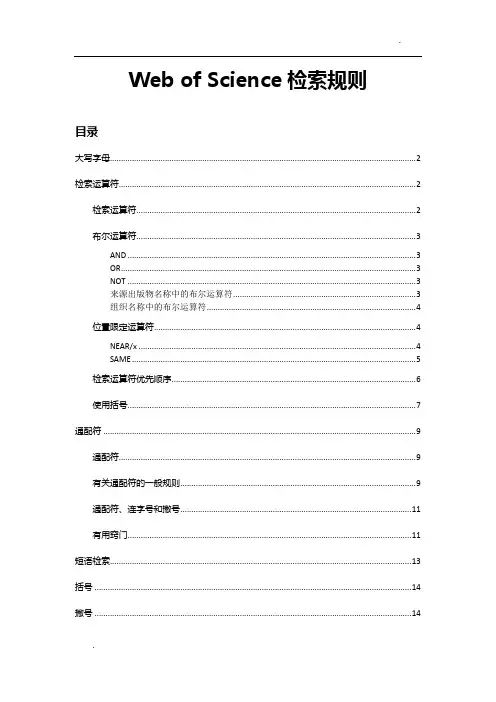
Web of Science检索规则目录大写字母 (2)检索运算符 (2)检索运算符 (2)布尔运算符 (3)AND (3)OR (3)NOT (3)来源出版物名称中的布尔运算符 (3)组织名称中的布尔运算符 (4)位置限定运算符 (4)NEAR/x (4)SAME (5)检索运算符优先顺序 (6)使用括号 (7)通配符 (9)通配符 (9)有关通配符的一般规则 (9)通配符、连字号和撇号 (11)有用窍门 (11)短语检索 (13)括号 (14)撇号 (14)连字号 (15)您知道吗 (15)大写字母不区分大小写:可以使用大写、小写或混合大小写。
例如,AIDS、Aids 以及aids 可查找相同的结果。
检索运算符在各个检索字段中,检索运算符(AND、OR、NOT、NEAR 和SAME)的使用会有所变化。
例如:●在“主题”字段中可以使用AND,但在“出版物名称”或“来源出版物”字段中却不能使用。
●您可以在多数字段中使用NEAR,但不要在“出版年”字段中使用。
●在“地址”字段中可以使用SAME,但不能在其他字段中使用。
请记住,使用检索运算符时不区分大小写。
例如,OR、Or 和or 返回的结果相同。
我们在示例中都使用大写字母只是为了样式美观起见。
注:Korean Journal Database 没有将SAME 包括为检索运算符。
检索运算符逻辑运算符AND、OR、NOT、NEAR 和SAME 可用于组配检索词,从而扩大或缩小检索范围。
请记住,使用检索运算符时不区分大小写。
例如,OR、Or 和or 返回的结果相同。
我们在示例中都使用大写字母只是为了样式美观起见。
注:Korean Journal Database 没有将SAME 包括为检索运算符。
此帮助页面包含以下主题信息。
●布尔运算符●位置限定运算符●检索运算符优先顺序●括号的使用布尔运算符AND使用AND 可查找包含被该运算符分开的所有检索词的记录。
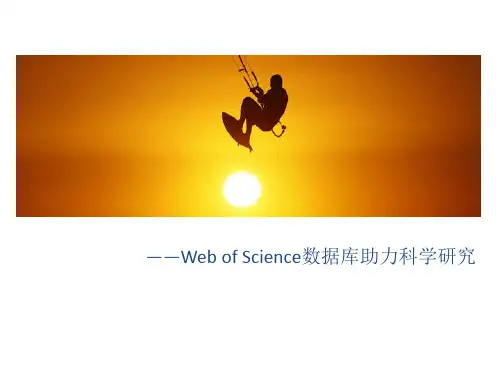
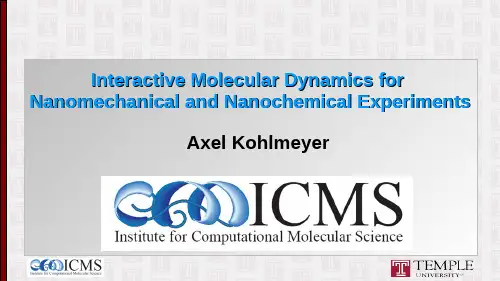
Interactive Molecular Dynamics for Nanomechanical and Nanochemical ExperimentsAxel KohlmeyerMolecular Dynamics●Simulate motion of atoms and molecules according to physical models: classical (empirical) or quantum (electrons and/or core)●Microscopic look into the atomic scale;simulated experiment with perfect control.●Connection to macroscopic world throughstatistical mechanics or thermodynamics:=> molecular level interpretation of thermodynamic quantities●Beyond two particles chaotic => coupled differential equations, solved numerically => model and CPU determine time scalesTypical Molecular Dynamics Work Flow●Setup: construct initial geometry, idealized or assembled pieces ●Equilibration: relax and propagate until the desiredthermodynamical state is reached (or close enough)●Production: propagate atoms and record statisticallyrelevant data of system evolution while equilibrium is maintained ●Analysis & Visualization: done “off-line” (i.e. after production)●Statistical analysis to derive structural or thermodynamicalproperties to confirm, guide or predict experiment(s).●Visual inspection of structural changes or “special” eventsStudying 'Rare Events' in Molecular Dynamics●Time scales in MD simulations are limited by the fastest motion => total time that can be studied is restricted.●Size of system is finite => large (local) energy fluctuations rare => events that have (free) energy barriers are often 'impossible'●Various 'biasing methods' exist to make those events possible=> biasing needs to be programmed, cannot “just play around”●Programmed biasing or steering works best for simple moves: 'collective variables' => well defined for statistical analysis●Difficult to study “What would happen if?”-scenarios on the flyEvolution of Interactive MD (IMD)●Origin in steered molecular dynamics (SMD) by adding run-time visualization to monitor the progress of steering●Next step: Interactive determination of steering forces through a pointer device (2d: mouse, 3d: 3d-joystick, 3d-mouse, WiiMote)●Then: better visual feedback with stereo displayeven better with 'immersive visualization', e.g. CAVE●Full IMD framework with support for haptic devicesadding force feedback to 3d tracking => VMD●Limited adoption due to cost and disruptive nature (VR facility)Interactive MD Applications Examples●Education and Outreach:Unique experience through immersive visualizationand force feedback allows students to “grasp” MD simulations●Simulation Monitoring:Visualization can be connected to ongoing production run●Simulation Preparation:Components of an MD simulation system can be interactivelyrearranged (“sculpting”) as needed while close to equilibrium●Nano-mechanical or -chemical experimentsThe IMD Infrastructure in VMDMD Engine:NAMD,Gromacs,HOOMD-blue,LAMMPS, ...Visualization& VR Client:VMDCoords FeedbackTrackerForcesVR Server:VRPN(-ICMS),Haptic deviceSocketSocketTime Scale Issues with IMDSimulated System:●Atom velocity: ~100 m/s●MD Time step: ~10-15 sTime and length scales of simulation & visualization are coupled Typical parameters for a smooth IMD configuration:Tangible System:●Compute time: ~1 ms / step●Atom movement: ~10-10 m / s Newton's second law: F = m a=> faster running MD=> less IMD force needed=> objects appear to be lighterTo move large object:=> run MD faster (parallel,GPU)=> or scale applied IMD force=> or change particle massMore Time Scale Issues with IMD●How realistic should an IMD simulation/visualization be?If too large IMD force, too small particle mass => unphysicalmay be tolerated for educational use, unacceptable for research●Local movements (solvent) limit length of time step●Compute capability limits speed of MD code●Visualization update rate limits position update frequency=> At higher MD speed, less frequent IMD position updates => position data becomes more “noisy”, need denoising filter●What if I want to look at “slow” processes? Move large objects?Recorded IMD Demos with “Falcon” Controller●“Stick the buckyballs intothe nanotube demo●Virtual vacuum AFM demowith 3 types of LJ particlesRevived Interest in Interactive MD●A smooth IMD visualization needs about 20-30 frames/s●Significant compute power for fast MD on all but the smallest systems●A powerful graphics workstation with stereo capability is required=> a dedicated and expensive facility was needed that few locations could afford and that would require to schedule access ahead of time ●3d screens affordable (3d-TVs, Scanline polarized LCD)●High performance graphics with 3d capability available (games)●Multi-core CPUs and GPUs turn workstations into clusters●Affordable controllers (Falcon (gaming), smartphones (6DOF))VRPN and VMD Enhancements●Support in VRPN for Novint Falcon as haptic 3DOF device●Implement Tracker and Button classes as sending devices●Implement ForceDevice class as receiving device●Use libnifalcon ( ) to access Falcon●Implement damping scheme for smooth force constraint updates(force update in device at 1000Hz, update from VMD less frequent)●Enhancements in VMD●Support for enforced TCP only communication with VRPN server forusing remote visualization facility via VirtualGL (LRZ Munich)●Support for whole residue mode with “tug” toolLAMMPS Enhancements●OpenMP (LAMMPS-ICMS) and GPU (GPULAMMPS) acceleration for non-bonded interactions=> faster MD for smaller (OpenMP) or larger (GPU) systems●Improvements in IMD module (fix imd):●Listening for IMD force input in separate thread.No more need to “drain” all incoming IMD communication data●Sending of coordinate data in separate threadNo more need to wait when large IMD data is sent over slow link●Addition of Savitzky-Golay filtering of coordinate dataDenoises coordinate updates with large Δt with minimal distortionIMD Appliance Concept●Combines:●Multi-core/CPU/GPU compute●Stereo capable visualization●3d display●Haptic device●Software●No special facility needed●Commodity components●Kiosk mode for educationPerspectives●Advances in GPU acceleration will expand applicability●GPU acceleration more effective in compute intense models=> nano-mechanics (Tersoff, Stillinger-Weber, AIREBO)=> nano-chemistry (Reaxx)●More approximate models for large changes(temporary coarse graining)●More experiments with example applications or demos needed ●IMD protocol expansions and optimizations●VRPN-ICMS improvements (multi-Falcon support, alternate grip)References●VMD: /Research/vmd●LAMMPS: /LAMMPS-ICMS (code gets merged to LAMMPS when stable): /site/akohlmey/software/lammps-icms●VRPN: /Research/vrpn/VRPN-ICMS (code will be merged into VRPN when stable): /site/akohlmey/software/vrpn-icms●GPULAMMPS (GPU acceleration with CUDA for LAMMPS):/p/gpulammps/●Michael L. Klein (freedom and funding, NSF CHE 09-46358)●John Stone, Klaus Schulten (VMD and much more)●Steve J. Plimpton, Paul S. Crozier and many others (LAMMPS)●Russ Taylor (VRPN), Kyle Machulis (libnifalcon)●Tom Anderson, Brandon Williams, Novint, (free Falcons) ...and...●Greg & Gary Scantlen, Creative Consultants,(contacts, encouragement, perseverance, 3D-buckyballs) Make sure you try out the “Nano Dome”, Booth 29/30.Acknowledgements。
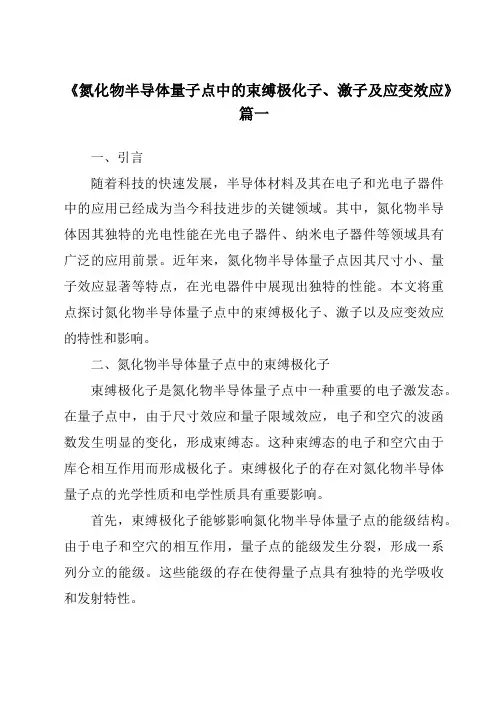
《氮化物半导体量子点中的束缚极化子、激子及应变效应》篇一一、引言随着科技的快速发展,半导体材料及其在电子和光电子器件中的应用已经成为当今科技进步的关键领域。
其中,氮化物半导体因其独特的光电性能在光电子器件、纳米电子器件等领域具有广泛的应用前景。
近年来,氮化物半导体量子点因其尺寸小、量子效应显著等特点,在光电器件中展现出独特的性能。
本文将重点探讨氮化物半导体量子点中的束缚极化子、激子以及应变效应的特性和影响。
二、氮化物半导体量子点中的束缚极化子束缚极化子是氮化物半导体量子点中一种重要的电子激发态。
在量子点中,由于尺寸效应和量子限域效应,电子和空穴的波函数发生明显的变化,形成束缚态。
这种束缚态的电子和空穴由于库仑相互作用而形成极化子。
束缚极化子的存在对氮化物半导体量子点的光学性质和电学性质具有重要影响。
首先,束缚极化子能够影响氮化物半导体量子点的能级结构。
由于电子和空穴的相互作用,量子点的能级发生分裂,形成一系列分立的能级。
这些能级的存在使得量子点具有独特的光学吸收和发射特性。
其次,束缚极化子还对氮化物半导体量子点的光电转换效率产生影响。
由于极化子的存在,量子点中的光生载流子更容易被分离和传输,从而提高光电转换效率。
三、氮化物半导体量子点中的激子激子是氮化物半导体量子点中另一种重要的电子激发态。
当光子能量大于半导体材料的带隙时,光子被吸收并激发出电子和空穴对,形成激子。
激子的存在对氮化物半导体量子点的发光性能具有重要影响。
首先,激子能够影响氮化物半导体量子点的发光颜色。
由于激子的能级与量子点的能级相匹配,激子的复合发光可以产生特定颜色的光。
通过调节激子的能级和数量,可以实现对氮化物半导体量子点发光颜色的调控。
其次,激子还对氮化物半导体量子点的发光效率产生影响。
激子的复合发光是发光效率的主要来源,因此激子的数量和寿命直接影响到量子点的发光效率。
通过优化激子的产生和复合过程,可以提高氮化物半导体量子点的发光效率。
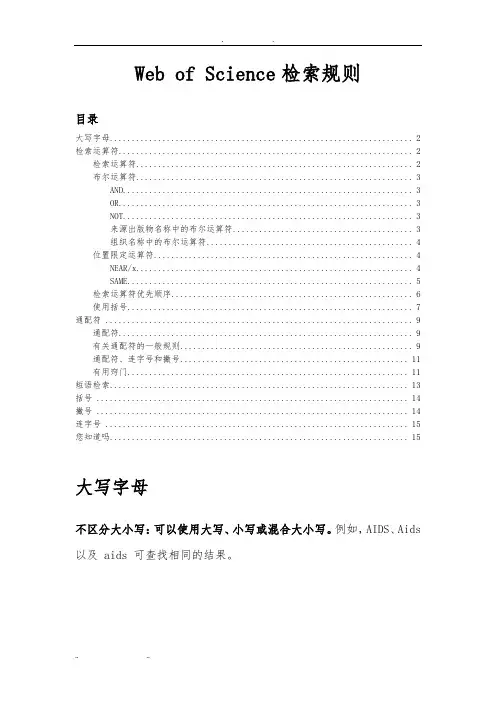
Web of Science检索规则目录大写字母 (2)检索运算符 (2)检索运算符 (2)布尔运算符 (3)AND (3)OR (3)NOT (3)来源出版物名称中的布尔运算符 (3)组织名称中的布尔运算符 (4)位置限定运算符 (4)NEAR/x (4)SAME (5)检索运算符优先顺序 (6)使用括号 (7)通配符 (9)通配符 (9)有关通配符的一般规则 (9)通配符、连字号和撇号 (11)有用窍门 (11)短语检索 (13)括号 (14)撇号 (14)连字号 (15)您知道吗... .. (15)大写字母不区分大小写:可以使用大写、小写或混合大小写。
例如,AIDS、Aids 以及 aids 可查找相同的结果。
检索运算符在各个检索字段中,检索运算符(AND、OR、NOT、NEAR 和 SAME)的使用会有所变化。
例如:●在“主题”字段中可以使用 AND,但在“出版物名称”或“来源出版物”字段中却不能使用。
●您可以在多数字段中使用 NEAR,但不要在“出版年”字段中使用。
●在“地址”字段中可以使用 SAME,但不能在其他字段中使用。
请记住,使用检索运算符时不区分大小写。
例如,OR、Or 和 or 返回的结果相同。
我们在示例中都使用大写字母只是为了样式美观起见。
注:Korean Journal Database 没有将 SAME 包括为检索运算符。
检索运算符逻辑运算符 AND、OR、NOT、NEAR 和 SAME 可用于组配检索词,从而扩大或缩小检索围。
请记住,使用检索运算符时不区分大小写。
例如,OR、Or 和 or 返回的结果相同。
我们在示例中都使用大写字母只是为了样式美观起见。
注:Korean Journal Database 没有将 SAME 包括为检索运算符。
此帮助页面包含以下主题信息。
●布尔运算符●位置限定运算符●检索运算符优先顺序●括号的使用布尔运算符AND使用 AND 可查找包含被该运算符分开的所有检索词的记录。
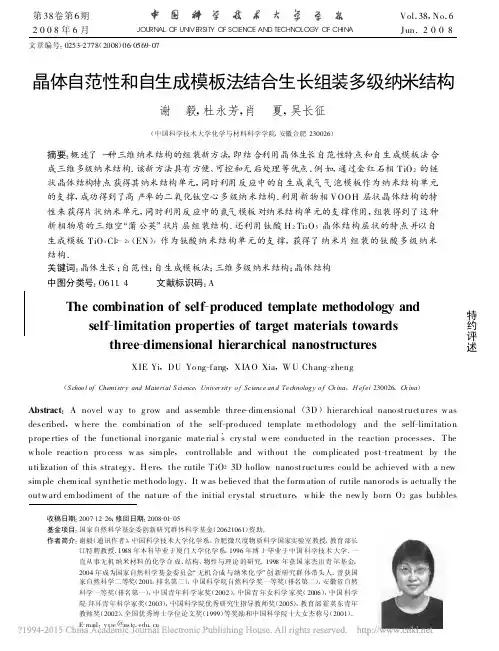
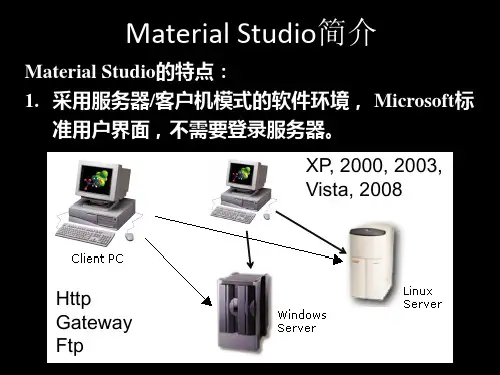
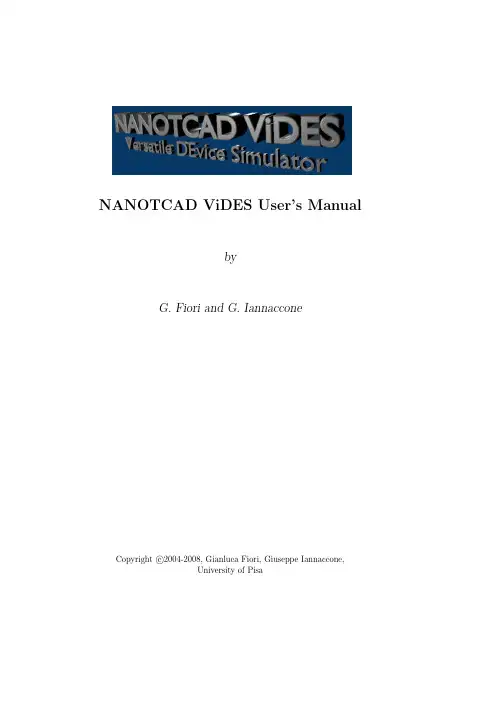
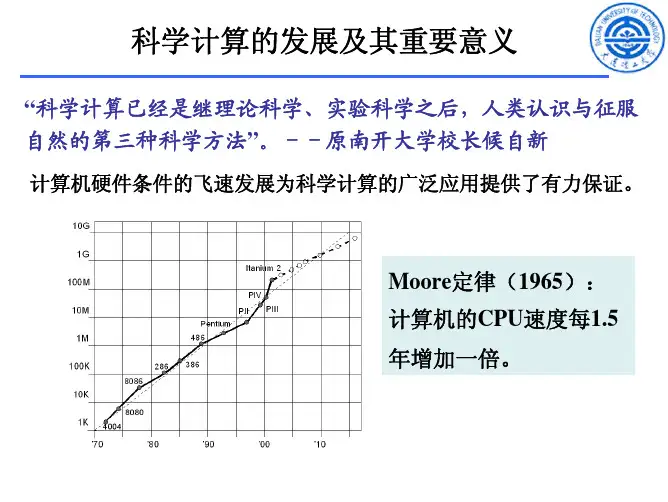
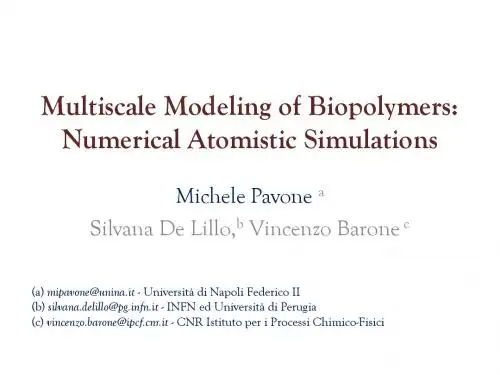
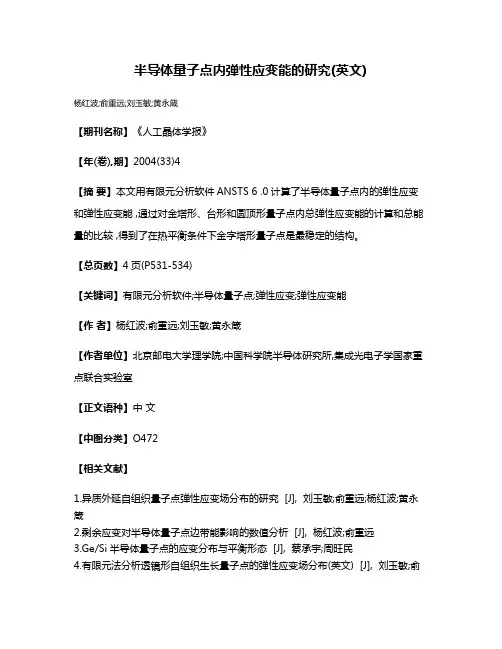
半导体量子点内弹性应变能的研究(英文)
杨红波;俞重远;刘玉敏;黄永箴
【期刊名称】《人工晶体学报》
【年(卷),期】2004(33)4
【摘要】本文用有限元分析软件ANSTS 6 .0计算了半导体量子点内的弹性应变和弹性应变能 ,通过对金塔形、台形和圆顶形量子点内总弹性应变能的计算和总能量的比较 ,得到了在热平衡条件下金字塔形量子点是最稳定的结构。
【总页数】4页(P531-534)
【关键词】有限元分析软件;半导体量子点;弹性应变;弹性应变能
【作者】杨红波;俞重远;刘玉敏;黄永箴
【作者单位】北京邮电大学理学院;中国科学院半导体研究所,集成光电子学国家重点联合实验室
【正文语种】中文
【中图分类】O472
【相关文献】
1.异质外延自组织量子点弹性应变场分布的研究 [J], 刘玉敏;俞重远;杨红波;黄永箴
2.剩余应变对半导体量子点边带能影响的数值分析 [J], 杨红波;俞重远
3.Ge/Si半导体量子点的应变分布与平衡形态 [J], 蔡承宇;周旺民
4.有限元法分析透镜形自组织生长量子点的弹性应变场分布(英文) [J], 刘玉敏;俞
重远;杨红波;黄永箴
5.1.55μm张应变InGaAsP/InGaAsP量子阱偏振不灵敏半导体光放大器的优化设计(英文) [J], 邱伟彬;何国敏;董杰;王圩
因版权原因,仅展示原文概要,查看原文内容请购买。
纳微米孔隙流体相态方程
纳米孔隙流体相态方程是描述纳米孔隙中流体相态变化的方程。
在纳米尺度下,流体的性质会发生显著变化,例如相变温度、相变压力、相变焓等都会发生变化。
因此,需要建立适合纳米尺度下的流体相态方程。
纳米孔隙流体相态方程可以用Gibbs自由能来描述,其一般形式为:$$。
G = G_{id} + G_{ex}。
$$其中,$G_{id}$是理想气体的Gibbs自由能,$G_{ex}$是非理想性引起的额外Gibbs自由能。
$G_{ex}$可以通过状态方程来计算,例如van der Waals方程、Redlich-Kwong方程等。
在纳米孔隙中,由于表面效应和限制效应的存在,流体的非理想性会更加显著。
因此,需要考虑更加复杂的状态方程,例如Dubinin方程、Dubinin-Radushkevich方程等。
这些方程可以更好地描述纳米孔隙中流体的相态变化。
总之,纳米孔隙流体相态方程是描述纳米孔隙中流体相态变化的重要工具,可以用于研究纳米孔隙材料的吸附、分离、传输等过程。
多孔硅发光中的极化子效应(英文)
邹炳锁;解思深
【期刊名称】《世界科技研究与发展》
【年(卷),期】2003(25)1
【摘要】多孔硅体现了许多新光学性质 ,本文通过温度依赖的发光、傅立叶红外谱、时间分辨红外谱的观察 ,发现了些有规律的信息。
众所周知 ,多孔硅在空气中陈化
氧化 ,导致内部纳米尺寸减小 ,界面层由氢变为氧。
我们发现同时伴随着电子态从
本征态向极化子态的变化。
前者随尺寸减小能量升高,表现为正常的量子限域效应。
而后者却随尺寸减小能量降低 ,表现为量子限域极化子效应。
温度依赖的发光谱型和强度变化也清楚地反映了尺寸依赖的极化子行为 ,因此我们提出了个基本的物理模型来描述多孔硅中增强的极化子尺寸效应及其光学行为。
【总页数】11页(P44-54)
【关键词】纳米硅;极化子效应;多孔硅;光学性能;傅立叶红外谱
【作者】邹炳锁;解思深
【作者单位】中科院物理所纳米物理与器件室
【正文语种】中文
【中图分类】TB321;TB383
【相关文献】
1.发光多孔硅二极管中负阻效应 [J], 苏宇欢
2.多孔硅发光二极管及其电致发光效率的提高 [J], 无
3.多孔硅的电致发光和发光二极管 [J], 杨国伟
4.金刚石膜在多孔硅发光中的应用(英文) [J], 王林军;夏义本;范轶敏;居建华;方志军;张伟丽;史伟民
因版权原因,仅展示原文概要,查看原文内容请购买。
粗粒化分子动力学模拟英文回答:Coarse-grained molecular dynamics (CGMD) simulation is a powerful computational technique used to study the behavior of large-scale molecular systems. In CGMD, instead of explicitly representing each atom in the system, groups of atoms are combined into a single "coarse-grained" particle. This simplification reduces the computational cost and allows for the simulation of longer timescales and larger systems compared to atomistic molecular dynamics simulations.CGMD simulations are particularly useful when studying systems with a large number of particles, such asbiological macromolecules or soft matter systems. For example, in the study of lipid bilayers, each lipid molecule can be represented as a single coarse-grained particle, capturing its overall shape andhydrophobic/hydrophilic properties. This allows for thesimulation of lipid bilayers containing thousands of lipids, which would be computationally infeasible using atomistic molecular dynamics.To perform a CGMD simulation, one needs to define the coarse-grained model, which involves determining the appropriate level of granularity and the mapping betweenthe coarse-grained and atomistic representations. The parameters of the coarse-grained potential, such as bond lengths, angles, and non-bonded interactions, also need to be determined. These parameters are often obtained byfitting to experimental data or higher-resolution simulations.Once the model is defined, the CGMD simulation proceeds similarly to atomistic molecular dynamics. The equations of motion are solved numerically to propagate the system in time, and various analysis techniques can be applied to study the system's behavior. For example, one can calculate the diffusion coefficient of a coarse-grained particle to investigate its mobility within the system.CGMD simulations have been successfully applied to a wide range of research areas, including the study ofprotein folding, self-assembly of nanoparticles, and the behavior of polymers. By providing insights into the collective behavior of large molecular systems, CGMD simulations contribute to our understanding of complex biological and materials phenomena.中文回答:粗粒化分子动力学模拟(Coarse-grained molecular dynamics,CGMD)是一种强大的计算技术,用于研究大规模分子系统的行为。
田云云-开题报告长江大学毕业论文(设计)开题报告题目名称含有单空位缺陷的金属碳纳米管电子结构的研究学院(系)物理科学与技术学院专业班级物理学生姓名田云云指导教师辅导教师开题报告日期2011年3月24日含有单空位缺陷的金属碳纳米管的电子结构的研究学生:指导教师:一、题目来源来源于曾晖老师的科研真题二、研究目的和意义碳纳米管是新型的一维纳米材料,具有优异的力学、热学和电子输运特性,目前,在实验制备中能够清楚地观测到空位缺陷的存在,并且能够采用电子束轰击的方式人为地在碳纳米管中构造空位缺陷。
特别是在制备分子电子学器件方面具有非常大的潜在价值。
例如可以利用碳纳米管制备纳米级导线和极细的电子枪。
然而,为了能用碳纳米管搭建成结构更为复杂的、并具有特定功能的分子器件,存在两个十分基本的问题。
第一是各种缺陷可能引起的效应,因为在制作器件的过程中必然要引入各种缺陷,例如原子空位缺陷,SW缺陷(由于碳管表面一个碳-碳键绕中心转过90°,使局部出现2个五环和2个七环的结构,也称为5-7-7-5缺陷)及吸附质的吸附等;第二是由多条路径相连接而成的结的性质。
本文主要研究各种四原子空位缺陷可能引起的效应,例如对其稳定性、电输运性方面的影响。
其研究结果对于将来采用碳纳米管作为新型纳米电子器件可提供一定的理论支持。
.研究对于将来采用碳纳米管作为新型纳米电子器件提供了理论支持。
三、阅读的主要参考文献及资料名称[1] S. Iijima, T. Ichihashi. Single-shell carbon nanotubes of 1-nm diameter [J]. Nature, 1993, 263, 603-605[2] R. H. Telling, C. P. Ewels, A. A. El-Barbary, M. I. Heggie. Wigner defects bridge the graphite gap [J]. Nat. Mater., 2004, 2(5):333-337[3] R. G. Amorim, A. Fazzio, A. Antonelli, F. D. Novaes, A. J. R. da Silva. Divacancies in Graphene and Carbon Nanotubes [J]. Nano Lett., 2007, 7(8):2459-2462[4] C. Jin, K. Suenaga, S. Iijima. V acancy Migrations in Carbon Nanotubes [J]. Nano Lett.,2008, 8(4):1127-1130[5] K. Suenaga, H. Wakabayashi, M. Koshino, Y. Sato, K. Urita, S. Iijima. Imaging active topological defects in carbon nanotubes [J]. Nat. Nanotechnol., 2007, 2(3):358-360 [6] Julio A. Rodriguez-Manzo, Florian Banhart. Creation of Individual V acancies in Carbon Nanotubes by Using an Electron Beam of 1? Diameter [J]. Nano Lett., 2009, 9(5):2285-2289[7] A. V. Krasheninnikov, F. Banhart. Engineering of nanostructured carbon materials with electron or ion beams [J]. Nat. Mater., 2007, 6(11):723-733[8] M K. Kostov, E E. Santiso, A M. George, K E. Gubbins, M. B. Nardelli. Dissociation of Water on Defective Carbon Substrates [J]. Phys. Rev. Lett., 2005, 95(4):136105[9] Savas Berber, Atsushi Oshiyama. Atomic and electronic structure of divacancies in carbon nanotubes [J]. Phys. Rev. B, 2008, 77(16):165405[10] J Kotakoski, A V. Krasheninnikov, K Nordlund. Energetics, structure, and long-rangeinteraction of vacancy-type defects in carbon nanotubes: Atomistic simulations [J].Phys. Rev. B, 2006, 74(5):245420[11] A R. Rocha, J E. Padilha, A Fazzio, A. J. R. da Silva. Transport properties of singlevacancies in nanotubes [J]. Phys. Rev. B, 2008, 77(15):153406[12] Takahiro Y amamoto, Y oshiki Nakazawa, Kazuyuki Watanabe. Control of electron- andphonon-derived thermal conductances in carbon nanotubes [J]. New J. Phys., 2007, 9(11):245[13]支少峰,张振华,邱明,彭景翠.单壁碳纳米管的电子速度及有效质量[J].物理化学学报, 2008,24(2):275-280[14]陆爱江,潘必才.单壁碳纳米管单原子空位缺陷的紧束缚理论研究[J],物理. 2004, 33(12):878-881[15]曾晖,韦建卫.双空位缺陷对金属性碳纳米管量子电子学特性的影响研究[J].[16]周涛. 碳纳米管中的缺陷及功能调制[D]. 北京:清华大学,2007[17]张增富,罗国华,范壮军,项荣,周丽,魏飞.不同结构碳纳米管的电磁波性能吸收性能研究[J].物理化学学报,2006,22(3):296-300[18]胡双林.低维材料第一性原理计算研究[D]. 安徽:中国科学技术大学,2009[19]张兆祥,侯士敏,赵兴钰,张浩,孙建平,刘维敏,薛增泉.单壁碳纳米管的场发射特性研究[N].物理学报.2002年2月,2:05[20]赵志伟, 张崇才. 碳纳米管及其应用研究进展[J]. 西华大学学报(自然科学版).2004, 20(16):423-427四、国内外现状和发展趋势与研究的方向在1991年日本NEC公司基础研究实验室的电子显微镜专家饭岛(Iijima)在高分辨透射电子显微镜下检验石墨电弧设备中产生的球状碳分子时,意外发现了由管状的同轴纳米管组成的碳分子,这就是现在被称作的“Carbon nanotube”,即碳纳米管,又名巴基管。
关于非对称的等离子纳米粒子三聚体的显著的局部圆二色性我们研究了银纳米粒子聚集体由圆偏振光激发的近场响应。
在一个直角三聚体系统,用右旋圆偏振光激发的局部电场强度比左旋情况大几乎一千倍。
通过分析等离子热点的局部场的偏振和相位,我们发现这个地方圆二色性源于采用正交偏振入射光激发的近场干扰。
当地的圆二色性可通过第三个粒子的旋转、颗粒间距离和介电环境调整。
这项这种现象也可能广泛存在于更复杂的纳米聚集体。
这些发现将受益于解决光霸道,提高圆二色性和旋光性。
Chiroptical效应的典型特征是左旋圆偏振光(LCP)和右旋圆偏振光(RCP)与手性分子的相互作用之间消光系数或折射率的小差异,导致了圆二色性(CD)或光学活性(OA)。
圆二色性(CD)光谱被广泛用于研究的有机和生物分子的细微结构信息。
高浓度和大量的手性样本通常被要求为可靠的信号 - 噪声。
借用分子学的概念,在金属纳米结构(如螺旋形,十字架,纳米棒,helixs,低聚物,pyramidals 等),已经观察到巨大的CD或OA响应。
手性分子和金属纳米粒子之间任一激发子 - 等离子体相互作用的机理,或者等离子纳米粒子和手性几何间的近场相互作用,使得CD或OA的反应比单纯的手性分子之一强多了。
手性分子表面增强的拉曼旋光性促进了金属纳米粒子等离子热点的形成。
纳米粒子聚合体的对称性变化将改变拉曼散射光的偏振响应。
此外,由于聚集体不同的吸附位,有可能产生新的手性中心,这使得它具有难获得到SEROA的稳定性和可重复性。
最近,人们发现即使在平面纳米颗粒的三聚体的非手性分子,该分子的拉曼散射可以有相当程度的圆偏振性,即,散射圆偏振拉曼光活性(SCP ROA)。
在分子聚合体系统中ROA等离子的源点也是通过分子的拉曼发射激发的非对称的粒子的nanoantenna效应。
单分子ROA可能为结构生物学和制药行业打开了新的视角。
实际上,在聚集体的纳米间隙中局部场也可以有CD特性,这可能会导致入射圆偏振ROA和局部散射OA。